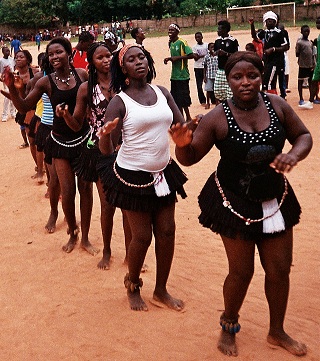
"Western Africa" story # 24
BECOMING BIJAGO
Bubaque, Guinea-Bissau
October 7, 2012
One day after visiting the beach of Bruce, I got to see the famous (but disappearing) Bijago skirts.
It was at a soccer tournament in the port town of Bubaque. The team from Etimbato Village was accompanied by a group of young women.
To cheer on their team, several of these women tapped handheld drums. The drums produced low tones - like a fisherman's plastic gasoline container bouncing around a rocky shoreline. The other women chanted in high happy voices. The chants were repetitive, and each chant ended with a long and soothing, musical note.
The upper thighs and healthy African buttocks of each woman were concealed by two rings made of hundreds of hanging sticks. The bottom ring had been dyed black. The upper ring was purple or brown or white, and black. I felt the tiny sticks of one woman's skirt; they seemed strong and sturdy, like tiny bamboo. These perfect skirts made their wearers much more special, in my eyes, than people wearing factory-made clothes.
Many of Etimbato's women also wore anklets. Eight or nine stones were tied loosely around their left ankles. When the women stomped, bare-foot, around the drummers, the stones clacked together to make a tambourine sound.
For some reason, watching these dancing women made me hungry.
I went to the market. I bought a big wedge of pumpkin and some eggplant. I cut them up and boiled the pumpkin for fifteen minutes, the eggplant for seven. They softened and became mushy. I ate a delicious pasta this day.
But, the following day was Thursday. On Thursday nights, jungle rat meat was in season, at a small market beside my house. I bought two boiled cubes of this meat, also known as "djikindo".
The cubes were smaller than tennis balls. They'd been flavored with black pepper and spices to eliminate the scent of wet fur. The meat was dark like something living in jungle shadows, dense and compact like a fat man who hoarded everything and feared open spaces.
Its texture resembled kidney meat in that it was soft and easy to bite through. The meat near its legs tasted like a dirty wet sock. I sucked the meat from the leg and found tiny bones that bent at the knee, with meat-less little feet. The djikindo tasted, in general, like a denser kidney meat (a bit red). Not bad.
A few days later, I went at night to visit the school where the young men and women who'd come for the soccer tournament were staying. Every evening, there was a party.
Three girls stood playing simple rhythms on low-pitched drums. Sometimes, the rhythms became complex, brief jams. "A-tap tap a-tap-tap-tap."
Twenty girls moved in a circle around the drummers, in this night without electricity illuminated by the full moon. They slouched their shoulders and bent forward as they stepped. Sometimes, they stepped backwards, pushing their butts into the laps of the girls behind them. Other times, they turned their butts outward from the circle and faced inward and stomped around.
The way they kept circling in one direction, it gave me vertigo; it felt like they were performing black magic. They often kept a fire going in the center of the circle. It felt like they were the hostile natives celebrating my capture.
As they slouched and strutted around the circle, the girls wore smiles of confidence, as if this were the absolute correct thing they were born to do, proud of their heritage.
I returned the following night, hopeful that I too could dance in this circle, as a few local men had done briefly.
But, the live traditional music had been replaced by European techno music on speakers.
Nevertheless, it was still a good night, as I ran into a lot of friends. These included the group of fishermen whom I'd met on my first night in the Archipelago of the Bijagos, and who had given me sea-turtle meat.
When I'd left my old neighborhood among the fishermen, and moved into a house of Father Luigi's which was solitary, I'd been rather sad. I would miss the fishermen. I would miss my girlfriend Patricia. I would miss the many kids of the neighborhood, including Patricia's Tatyana and Fenda, who had staring contests with me and tickled me.
I hoped to visit them frequently.
Now, Julho the Fisherman greeted and conversed with me in the Bijagos' language. WIth a short stature and a shaven head, he looked much younger than his forty years. His eyes were usually red with caju wine. He smiled to see me.
Fire the Fat Fisherman greeted me in Bijago, and made jokes suggesting Neto the Fisherman masturbated a lot.
"Orane tidan ngobotre?" (Are we going fishing tomorrow?) It was a mutual desire that I would join them in fishing one day. We all hoped it was going to happen. I would try not to sit too close to Neto on the canoe, though.
This year's soccer tournament had brought people to our island from all over the archipelago. These people overheard me speaking their language, and they greeted me too. They were delighted to hear a non-Bijago person speaking Bijago.
They were used to speaking Creole with other ethnicities, and Portuguese or Creole with other nationalities. The uniting language of Guinea-Bissau, Creole (an Africanization of Portuguese), had a much wider usefulness than Bijago. Bijago, in fact, varied so much from island to island (which were often in sight of one another) that one's inhabitants could barely understand the other's.
Creole sometimes seemed to me to be a harsh language, a language in which people argued over money.
But, people were always happy speaking Bijago. And I was happy speaking it with them.

"Nyimarika" (I'll come again soon),
"To shotra" (Until tomorrow),
the Modern Oddyseus